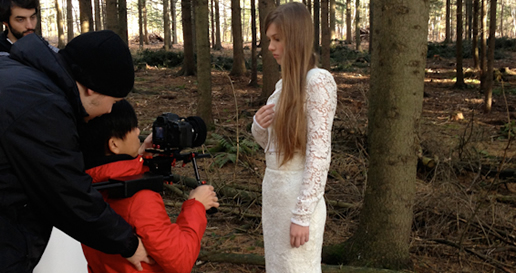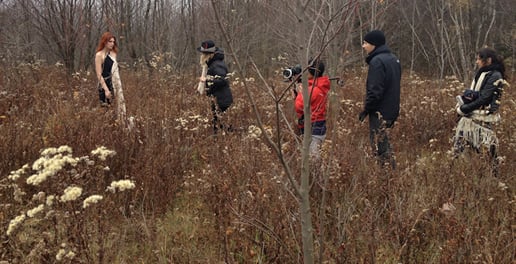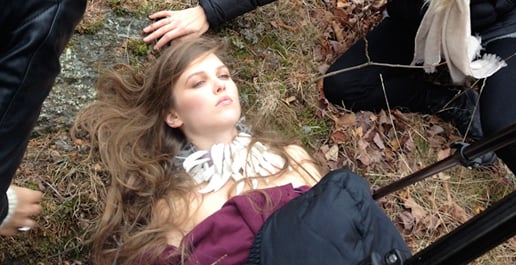Cameras: News and Updates
| Fashion Video Lookbooks on DSLR: Interview with Herve Demers By Wynona Luz posted May 23, 2013, 15:34 |
 |
Canadian Director Hervé Demers Discusses Fashion Filmmaking on DSLR
When did you begin using DSLR cameras, and what first influenced or inspired you to use DSLR cameras to shoot video?
Hervé Demers: My earliest narrative shorts were made with a small DV camera that I always loved to operate myself. Since I had been involved in photography a longtime beforehand, it was a natural thing for me to work like this. With the DSLR cameras, I rediscovered this intuitive process. This incredible lightness and freedom. It opened up new possibilities.
What DSLR cameras do you use to shoot your fashion video lookbooks?
Hervé Demers: For my first three fashion films, the Canon 5D Mark II was my camera of choice. I was using an optical anti-moiré filter on the camera’s sensor that allowed me to reduce the aliasing/moiré problem significantly. To this day, I still cannot justify the upgrade to the MKIII.
What kinds of DSLR tools, technologies, and gear do you use for fashion and beauty videography projects versus narrative filmmaking projects?
Hervé Demers: I think the main difference between these two types of projects is not technical. It’s the crew you are working with! The fashion/beauty films are a highly stylized and artificial construction that requires a team similar to the one you’d find on a fashion photography shoot. It’s a place where the director’s key collaborators are the stylist, the makeup artist and the hair stylist. It’s a very different way to work, but the tools can be pretty much the same.
What’s interesting in regard to the DSLR technology is that the whole “genre” of the fashion film literally exploded at the same time the DSLRs started to become widely available. DSLRs made it possible for emerging designers, magazines and blogs to afford the production of high-quality videos for the Web. Some of these DSLR videos even got way more attention than much more expensive productions!
In regard to narrative works, I have also used the Canon 5D Mark II a few times. But as most people know, its sound recording capacity is very limited. This problem forced us to record sound separately to get the best possible quality and the pain came afterwards: when the editor had to sync the whole thing! Even with proper syncing software, it is still a hassle. When you take time to evaluate the costs carefully, you realize that for narrative films you might be better off renting a camera that is really built for Cinema/TV production. Something as accessible as a C300 would do. Otherwise, you will need to pay your editor to work on this time-consuming task or end up doing it yourself while you should be concentrating on “creative” editing. It becomes a solid waste of time.
When shooting for fashion video lookbooks, what's your camera to post workflow like? (And what tools and technologies do you use during editing and post production?)
Hervé Demers: Adobe was the first software company to understand the needs of the DSLR users, and they built their new editing suite with them in mind. Today, when using 5Ds, I always tend to go for Adobe software, even if I’m on a Mac. They made it possible to edit H264 in real-time and they allowed us to bring that limited 8-bit codec instantly in a 32-bit color space. Their solution is intuitive, and it works. For color correction, going forth between linked Premiere/After Effects sequences is key, because it allows me to go as far as I can without any quality loss.
Taking from your experience working in the field, what are some of the major advantages you've experienced shooting with DSLR cameras?
Hervé Demers: I believe it is their small size and low-light ability that attracted me at first. Plus the fact that they are so cheap! It allowed me to use more than one camera simultaneously on many shoots.
If you could share an interesting challenge and solution in relation to DSLR cinematography and/or DSLR workflow, what would they be?
Hervé Demers: When we were shooting Winds of Autumn, we had about 15 to 20 minutes to film the snow geese lifting from the lake at dawn. After that, they would all be gone and we’d have to move on to other locations. So there was no way to get different angles/focal lengths with a single camera. Using a few DSLRs allowed us to cover the scene extensively in a VERY short amount of shooting time. I believe it could not have been possible otherwise, especially at such a low cost.
If you could share some advice, insights, or an inspirational tidbit in relation to learning and working with DSLR cameras, technologies, and workflows, what would you share with filmmakers, videographers, and storytellers around the world?
Hervé Demers: When these cameras came out, many people spoke of a “revolution”. I think they were right. For me, certain types of projects were literally made possible by the availability of these tools.
If I had something to say to film students, it would be that, in my mind, the main challenge for a young director is to anticipate precisely the way space and time will be reproduced as a sequence of moving images and how these recorded fragments will relate to each other once they are organized on a timeline. I believe this process of visualization is the main skill filmmakers have to rely on in order to express anything. But there is only one way to get better at it: by filming and editing constantly. And I’m pretty sure a student could not dream of a better tool to experiment with.

